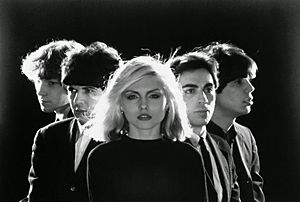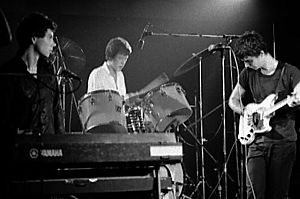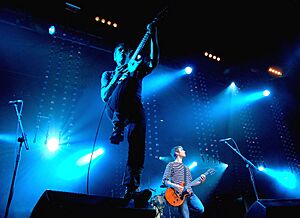New wave music facts for kids
Quick facts for kids New wave |
|
|---|---|
| Stylistic origins |
|
| Cultural origins | Mid-to-late 1970s |
| Derivative forms |
|
| Subgenres | |
|
|
| Fusion genres | |
| Two-tone | |
| Regional scenes | |
|
|
| Other topics | |
|
|
New wave is a type of music that was popular from the 1970s to the 1980s. It mixed pop sounds with the energy of punk rock. People first used "new wave" to describe many different music styles that appeared after punk rock. Later, it became a general term for popular music styles like synth-pop, alternative dance, and post-punk. The main new wave period happened in the late 1970s and continued into the early 1980s.
New wave music often had a fun or quirky pop sound. It used sharp guitar riffs, sudden rhythms, and electronic sounds. It also had a unique visual style in fashion. In the early 1980s, many new pop and rock bands, especially those using synthesizers, were called "new wave" in the United States. New wave bands shared punk's "do-it-yourself" idea. However, they were more inspired by 1950s styles and lighter 1960s pop. They often didn't like the harsh, political side of punk rock or what they called boring "corporate rock".
New wave was most popular from the late 1970s to the early 1980s. Many famous musicians and "one-hit wonders" came from this genre. MTV, a music TV channel that started in 1981, played many new wave music videos. This helped the genre become very popular in the United States. In the UK, new wave became less popular in the early 1980s when the New Romantic movement started. In the US, new wave lasted until the mid-1980s but then declined as New Romantic and new pop music became popular. Since the 1990s, new wave has become popular again several times, as people remember and enjoy its music.
Contents
What Makes New Wave Music Special?
New wave music included many different styles. They often shared a quirky, lighthearted, and funny feeling. These styles were popular in the late 1970s and early 1980s. New wave music often used electronic sounds and had a special look in music videos and fashion.
Music expert Simon Reynolds said new wave music felt jumpy and energetic. New wave musicians often played choppy rhythm guitars with fast speeds. Keyboards and songs with sudden starts and stops were also common. Reynolds noted that new wave singers often had high-pitched, slightly nerdy voices.
Many early new wave artists were British. These bands became popular in America partly because of channels like MTV. MTV played British new wave music videos because many American hit songs did not have videos yet. According to music producer Steve Greenberg, British videos were easy to find. They had been a regular part of UK pop music TV shows like Top of the Pops since the mid-1970s. This rise in technology made the visual style of new wave musicians very important for their success.
Many new wave fans and bands, like Talking Heads, Devo, and Elvis Costello, had a nervous or nerdy image. This showed up in robotic dancing, shaky high-pitched singing, and clothes that hid the body, like suits and big glasses. This look seemed very different to audiences used to disco dancing or macho "rock" styles.

New wave tried to mix the energy of punk with traditional pop songwriting. You can see this in the rockabilly sounds of Elvis Costello and the 1960s mod influences of the Jam. Paul Weller from The Jam called new wave "the pop music of the Seventies." He explained in 1977:
It’s just pop music and that’s why I like it. It’s all about hooks and guitar riffs. That’s what the new wave is all about. It’s not heavy and negative like all that Iggy and New York stuff. The new wave is today’s pop music for today’s kids, it’s as simple as that. And you can count the bands that do it well and are going to last on one hand. The Pistols, The Damned, The Clash, The Ramones – and The Jam.
New wave bands shared punk's "do-it-yourself" idea. But they were more inspired by the lighter pop sounds of the 1960s. They did not like mainstream "corporate" rock, which they thought was boring. They also disliked the harsh and political side of punk rock. In the early 1980s, especially in the United States, many new wave bands mixed pop and rock music with African and African-American styles. Bands like Adam and the Ants and Bow Wow Wow used drumming styles similar to those from Burundi. The Talking Heads' album Remain in Light was praised for mixing new wave and African sounds. Later, African-American musicians like Grace Jones, Janet Jackson, and Prince used new wave influences. Prince, in particular, used these sounds to create the "Minneapolis sound."
How New Wave Music Started
The term "new wave" is sometimes seen as too broad and "almost meaningless." It first appeared as a general term for music that came after punk rock, including punk itself, in Britain. Scholar Theo Cateforis said the media used the term to make punk groups more appealing to the public.
Punk rock or new wave bands strongly showed they were unhappy with the rock music of their time. They disliked big progressive rock groups like Emerson Lake and Palmer and Pink Floyd. Instead, they focused on a simpler sound… However, the media showed punk groups like the Sex Pistols and their fans as violent. Punk then got a bad reputation, especially in the United States, which made the music hard to sell. At the same time, bands like the Cars, the Police and Elvis Costello and the Attractions appeared. They mixed the energy of punk with a more friendly sound for radio. These groups were all grouped together and sold only as "new wave."
As early as 1973, critics like Nick Kent and Dave Marsh used "new wave" for New York bands such as the Velvet Underground and New York Dolls. In the US, many early new wave groups were less "punk" and were linked to the CBGB club. Examples include Talking Heads, Mink DeVille, and Blondie. The proto-punk scene in Ohio also had new wave bands like Devo. Hilly Kristal, who owned CBGB, said the first show by Television at his club in March 1974 was "the beginning of new wave." Many musicians first called punk were also later called new wave. A 1977 album called New Wave included American bands like Dead Boys, Ramones, and Talking Heads.
Between 1976 and 1977, "new wave" and "punk" were often used to mean the same thing. Music historian Vernon Joynson said new wave started in the UK in late 1976. This was when many bands began to separate themselves from punk. That year, the term became more common in UK punk magazines and music newspapers. In November 1976, Caroline Coon used Malcolm McLaren's term "new wave" for bands that were not exactly punk but were connected to the punk music scene. The British pub rock scene of the mid-1970s produced many successful new wave acts. These included Ian Dury, Nick Lowe, and Dr. Feelgood.
In the US, Sire Records chairman Seymour Stein thought the term "punk" would lead to low sales. So, he started a "Don't Call It Punk" campaign. He wanted to replace "punk" with "new wave." Radio experts in the US had said punk rock was just a passing trend. So, they chose the new term. Like the filmmakers of the French New Wave movement, after whom the music genre was named, new wave bands like Ramones and Talking Heads were against big corporations and liked to experiment. At first, most American writers used "new wave" only for British punk bands. Starting in December 1976, The New York Rocker magazine began using the term. They used it first for British bands and then for bands from the CBGB scene. The simple style and fast pace of the music attracted them. Stein and others saw it as a needed return to the energetic rock and roll of the 1960s. This energy had decreased in the 1970s with progressive rock and huge stadium shows.
The term "post-punk" was created for groups who were first called new wave. But these groups were more serious, challenging, darker, and less focused on pop. Some of these groups later started using synthesizers. Punk rock had a big impact on music in the UK. But in the US, it mostly stayed in the underground music scene.
By the end of 1977, "new wave" had replaced "punk" as the term for new underground music in the UK. In early 1978, XTC released the song "This Is Pop" to respond to labels like "new wave." Songwriter Andy Partridge later said of bands given these labels: "Let's be honest about this. This is pop, what we're playing... don't try to give it any fancy new names... because it's clearly just pop music. We were a new pop group. That's all."
New Wave in the 1980s
In the early 1980s, new wave slowly lost its connection to punk for some Americans. Music critic Bill Flanagan wrote in 1989 that "the last bits of Punk were removed from New Wave." New Wave went from meaning Talking Heads to meaning the Cars, then Squeeze, Duran Duran, and finally Wham!. However, for many critics, new wave stayed linked to the punk/new wave period of the late 1970s.
Lester Bangs, another critic who supported punk and new wave in the 1970s, was asked in 1982 if new wave was "still going on." He said, "The only problem with New Wave is that nobody continued it... But it was a really exciting burst for about a year, year and a half." Around 1983, the US music industry started using the more general term "new music." This term was used for new styles like new pop and New Romanticism.
In 1981, the launch of MTV began new wave's most successful time in the US. British musicians, unlike many American ones, had learned how to use music videos early on. Several British bands on independent labels were able to sell more music than American musicians on major labels. Journalists called this the "Second British Invasion" of "new music." This included many artists from the New Romantic movement. MTV continued to play many videos by "post-New Wave pop" bands from Britain until 1987. Then, it changed to a heavy metal and rock-focused format.
In a December 1982 Gallup poll, 14% of teenagers said new wave was their favorite music. This made it the third most popular type of music. New wave was most popular on the West Coast. The poll also showed that a person's race did not affect how popular new wave music was for them. Urban contemporary radio stations were the first to play dance-focused new wave bands like the B-52's, Culture Club, Duran Duran, and ABC.
New wave songs were used in popular "Brat Pack" films like Sixteen Candles, Pretty in Pink, and The Breakfast Club. They also appeared in the low-budget hit Valley Girl. John Hughes, who directed some of these films, loved British new wave music. He put songs from bands like the Psychedelic Furs, Simple Minds, and Orchestral Manoeuvres in the Dark in his movies. This helped keep new wave popular. Many of these songs are still remembered from that time.
In September 1988, Billboard magazine started its Modern Rock chart. The bands on this chart showed many different styles. New wave's influence remained strong. Many bands from the UK and bands popular in rock discos were featured. The chart's name, "Modern Rock," also showed how new wave was sold as "modern." According to Steve Graves, new wave's independent spirit was key to the growth of college rock and grunge/alternative rock in the late 1980s and beyond.
New Wave's Influence Today
In the US, new wave continued into the mid-1980s but then became less popular. This happened as New Romantic, new pop, and other new music styles grew. Some new wave bands, like R.E.M., kept their independent label focus through most of the 1980s. They turned down offers for more money from major labels. In the UK, new wave "lasted through the post-punk years." But after 1980, it was "overwhelmed by the more flashy style of the New Romantics."
In response, many British independent bands started using "the kind of jangling guitar work that had defined New Wave music." The arrival of the Smiths was seen by music writers as a "reaction against the richness of New Pop." It was "part of the move back to guitar-driven music after the keyboard sounds of the New Romantics." After grunge music, British music writers tried to promote a "new wave of new wave." This included bands like Elastica that were clearly influenced by punk and new wave. However, this was soon overshadowed by Britpop, which took ideas from both 1960s rock and 1970s punk and new wave.
In the 2000s, many bands appeared that used different new wave and post-punk influences. These bands were sometimes called "New New Wave." According to British music journalist Chris Nickson, the Scottish band Franz Ferdinand brought back both Britpop and late 1970s music with their "New Wave influenced sound." AllMusic notes that these bands led journalists and fans to talk about a "post-punk/new wave revival." They argue it was "really more like a continuous line, one that could be traced back as early as the mid-'80s."



